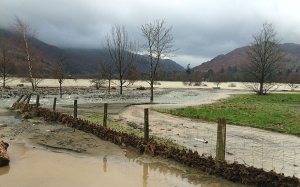National flood resilience review to consider better upstream water management
Ministers have been forced to bow to public criticism over its ability cope with extreme weather episodes, such as the one which left hundreds of people washed out of their homes in Keswick and Carlisle this month. The result? A major review of Britain’s plans for coping with “worst case” floods.
The Environment Secretary, Liz Truss has announced a National Flood Resilience Review to better protect the country from future flooding and increasingly extreme weather events.
She outlined how her department would look afresh at how we calculate flood risk, in light of recent events, to be delivered by a new cross Government team. This will see Government updating ‘worst case scenario’ planning, considering the future impacts of climate change and carrying out a risk assessment of critical infrastructure, like electricity substations.
The review, also to be published next summer, will be led by Oliver Letwin and include the Government’s Chief Scientist, Defra, DECC, DCLG, HMT and the Chief Executive of the Environment Agency.
This will re-examine how the government calculated flood risk for different areas, update official “worst case scenario” planning, and consider the future impact of climate change.
Ms Truss said: “After seeing first-hand the impact of the flooding in the north of England, it is clear that the growing threat from more extreme weather events means we must reassure ourselves, and those communities at risk, that our defences, our modelling and our future plans are robust.”
She warned that the country faced a “growing threat” from flooding and needed to overhaul its contingency plans to cope with more severe storms in future.
Support following downturn in funding
The announcement came after criticism for approving cuts in flood defence spending, which is being slashed by 14 per cent this financial year. The Government had reduced funding by £116million, earmarking just £695million for flooding and erosion in 2015/16, compared with £811million the previous year following the 2013/14 floods.
It is the biggest year-on-year fall since 2011/12, according to figures from the Department for Environment, Food and Rural Affairs.
Following the 2013/14 floods which left the Somerset Levels underwater for weeks the Prime Minister had claimed “money is no object” when it came to tackling flooding. As a result, with communities once again struggling to cope with flood waters, ministers have been coming under mounting pressure to explain why funding for flood prevention was cut.
New partnership for Cumbria
As part of the review the Government is to launch a new “Cumbrian Floods Partnership” to identify the extra defences that are required to protect the area from being overwhelmed by storms in future.
The new Partnership group will consider what improvements to flood defences in the region may be needed, look at upstream options for slowing key rivers to reduce the intensity of water flows at peak times and build stronger links between local residents, community groups and flood defence planning.
The group, who will publish a Cumbria Action Plan next summer, will be chaired by Floods Minister Rory Stewart and made up of local authorities, the Environment Agency and community flood defence groups.
Schemes could include measures to slow down the flow of rivers to reduce the “intensity of water flows at peak times”, officials said.

Flood damage around the village of Glenridding in Cumbria Photo: PA
Environmental campaigner and journalist George Monbiot has earned the ire of farmers in Cumbria by saying their practices contributed to the flooding. He wrote: “A rational policy would aim to prevent the flood from gathering in the first place. It would address the problem, literally and metaphorically, upstream.
“A study in mid-Wales suggests that rainwater’s infiltration rate into the soil is 67 times higher under trees than under sheep pasture. Rain that percolates into the soil is released more slowly than rain that flashes over the surface. ”
The Review will be at its most effective when it considers more sustainable drainage management rather than purely focussing on defence spend. At the heart of this will be more rigorous catchment modelling to understand current and future predictions of water flow in specific environments and what each measure can do to mitigate them.
The lessons from Cumbria suggests the modelling should account for ever higher extremes and use all available resources and thinking. Time will tell.
The title image is of Carlisle after Storm Desmond – credit to EPA.



